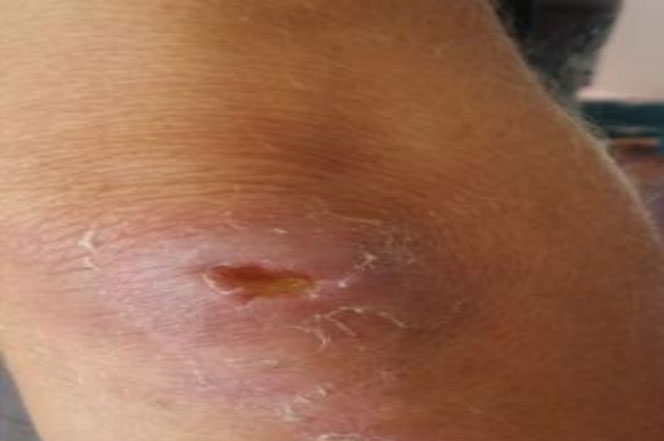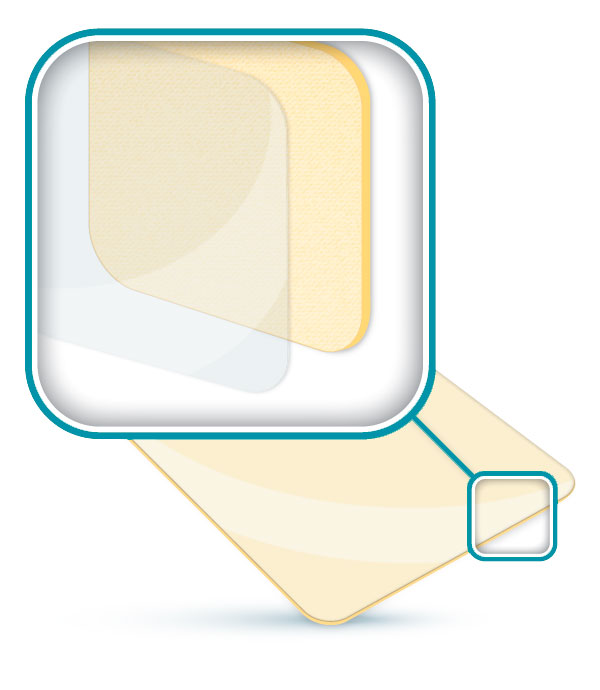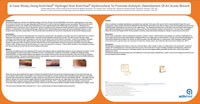Clinical Resource: A Case Study Using ActivHeal® Hydrogel And ActivHeal® Hydrocolloid To Promote Autolytic Debridement Of An Acute Wound
Lyndsay MacCallum and Rebecca Forder
Clinical Support Nurse Advanced Medical Solutions Ltd,
Clinical Research Manager Advanced Medical Solutions Ltd
Clinical Resource
A Case Study Using ActivHeal® Hydrogel And ActivHeal® Hydrocolloid To Promote Autolytic Debridement Of An Acute Wound
Lyndsay MacCallum and Rebecca Forder
Clinical Support Nurse Advanced Medical Solutions Ltd,
Clinical Research Manager Advanced Medical Solutions Ltd
BACKGROUND
Wounds are defined as a break in the epithelial integrity of the skin (Enoch and Price, 2004). When this barrier is disrupted due to any cause, the functions of the skin are no longer adequately performed and it is vital to restore its integrity as soon as possible. Effective acute wound management involves a full, holistic wound assessment as every patient presents with different signs and symptoms. Dressings are a fundamental part of caring for a wound. Wounds are common in sport and can present as bruises, abrasions, burns, laceration punctures, blisters or a combination of all of these (McDonagh, Zideman 2015). Most of these acute wounds will heal as anticipated however, on this occasion there was some contamination in the wound bed which prevented the wound from following the normal wound healing process.
INTRODUCTION
Mr M is a fit healthy 40 year old male taking part in an endurance cycling event. He sustained a traumatic wound to his right elbow as a result of falling from his bicycle onto an asphalt surface. Traumatic wounds typically produces dirty wounds. The rate of wound recovery varies according to the extent and type of damage incurred and intrinsic factors such as the patient’s circulation, nutrition and hydration (Edwards and Griffiths,2011). First aid was initially carried out by the patient himself however the wound did not heal as anticipated and went onto develop a small cavity with a sloughy wound bed. Wounds that are not cleaned within six hours of injury are more likely to become infected (Gottrup,1999). Sloughy tissue can attract bacteria to a wound increasing risk of infection (O’Brien,2002) therefore it was important to remove this risk and create an environment for wound healing to take place.
METHOD
Following a full patient and wound assessment the wound was cleansed using an antibacterial solution to remove bacteria and debris. As the wound appeared to show the early signs of infection of new or increasing pain, erythema, local warmth, swelling and delayed healing (WUWHS, 2008) an antimicrobial ointment was applied to the surface of the wound to reduce the bioburden of the wound with an ActivHeal® hydrocolloid dressing. The topical antibacterial ointment was selected to assist in reducing the bioburden within the wound (EWMA, 2006) and the ActivHeal® Hydrocolloid as a secondary dressing.

Figure 1
Wound on initial assessment 06/07/15

Figure 2
Wound reassessed on 09/07/15

Figure 3
Wound on the 14/07/15
When the wound was reassessed the signs of infection had abated however the wound bed remained sloughy. As the wound bed was dry and contained 100% slough it was decided to use Activheal® Hydrogel as a primary dressing with Activheal® Hydrocolloid as a secondary dressing. Both dressings were selected to create a moist wound environment to allow the wound to autolytically debride. Hydrogels have the ability to hydrate a dry wound surface rapidly (Weir,2012) and debridement removes the non viable tissue to provide a wound environment that is less likely to support a heavy growth of bacteria (Vowden & Vowden, 2011). Hydrocolloids provide and maintain a moist wound environment that supports the healing process (Finnie, 2002) and that it also has the ability to facilitate autolytic debridement (Hegder, 2012).
The wound was redressed at 2-3 day intervals over a 2 week period and wound progress was documented.
RESULTS
There is evidence of autolytic debridement, granulation and reduction of the size of the wound which is demonstrated through the use of photographs. (Figure 3) Both ActivHeal® Hydrogel and ActivHeal® Hydrocolloid were able to create a moist wound healing environment that enabled autolytic debridement and removal of non viable tissue. The dressings had been both comfortable and conformable whilst staying in place effectively despite Mr M continuing with the cycling event and environmental conditions of heat and sun. The event was completed before the wound had healed but Mr. M was advised to continue using Hydrocolloid dressings to maintain a moist wound environment.

DISCUSSION
Proper wound preparation improves healing and outcomes (Howell, Chisolm, 1992). Autolysis was selected as a method of debridement on this occasion as the wound was small however contained 100% of non viable tissue in the wound bed. The use of ActivHeal® Hydrogel and Hydrocolloid dressings allowed the process to be carried out while the patient was still taking part in a cycling event. Both dressings created a moist environment which uses the body’s own enzymes to break down sloughy tissue, and create the right environment (Ousey et al, 2011).
CONCLUSION
Debridement is indicated when there is a build up of necrotic tissue, callus, slough or other non-viable tissue in the wound bed (Vowden & Vowden 2011). Debridement is a natural process that occurs in all wounds and is crucial to healing: damaged and dead tissue, debris and bacteria are removed from the wound, minimising infection risk and encouraging healthy granulation tissue to form, which aids healing (Strohal et al, 2013). Activheal® Hydrogel and Hydrocolloid dressings were used effectively to promote autolytic debridement, create a moist wound healing environment and promote effective wound healing.
References
Edwards, M. & Griffiths,P. (2011) Emergency Nursing Made Incredibly Easy. Lippincoot Williams & Wilkin. London.
Enoch,S. & Price,P. (2004) Cellular, molecular and biochemical differences in the pathophusiology of healing between acute wounds, chronic wounds and wounds in the aged. www.worldwidewounds.com/2004/august/Enoch/pathophysiology-of healing. Accessed 21/10/15.
European Wound Management Association [EWMA](2006) European Wound Management Association Position Document, Identiying Criteria for Wound Infection. London, United Kingdom:MEP ltd.
Gottrup,F. (1999) Wound Closure Tecniques. Journal of Woundcare. 8 (8).pg 397-400.
Hedger,C. (2012) Choosing the appropriate dressing: Hydrocolloids. Wounds Essesntial. Vol2. Pg 13-15
Howell JM, Chisholm CD (1992) Outpatient wound preparation and care: a national survey. Ann Emerg Med 21(8):976–981
McDonagh, D. Zideman,D (2015) The IOC Manual of Emergency Sports Medicine. International Olympic Committee John Wiley and Sons.
O’Brien M (2002) Exploring methods of wound debridement. British Journal of Community Nursing; 10: 12, 10-18.
Strohal R et al (2013) EWMA document: debridement. An updated overview and clarification of the principle role of debridement. Journal of Wound Care; 22: S1–S52.
Weir,D. (2012) How to … Top tips for wound dressing selection. Wounds International. Vol3 Issue 4. Pg 18- 22.
Finnie,A (2002) Hydrocolloids in wound management: pros and cons. British Journal of Community Nursing 7 (7) : 338-42
Ousey et al (2011) This case series highlight the clinical effectiveness of the ActivHeal wound care dressing range. British Journal of
Nursing
CONTACT US FOR MORE INFORMATION
Discover ActivHeal®
Social Media
Our Product Range
AMS Group
ActivHeal®, its logo and the Advanced Medical Solutions logos are registered trademarks of Advanced Medical Solutions Ltd.
Copyright © Advanced Medical Solutions Limited | Design by Lumisi Ltd


